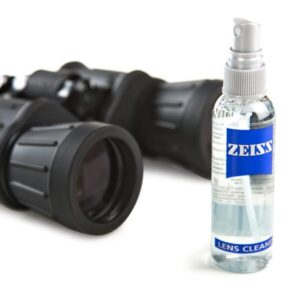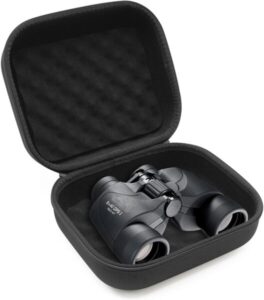Keeping your binoculars clean is important if you want them to last long. Binoculars are great investments that people make and protecting them starts with keeping them clean. When used regularly, binoculars get dirty. Both the lenses and the body go through a lot of commotion and accumulate dirt and dust. But, it’s easy to keep them clean and bright for many years.
How to Clean Binoculars: 5 Steps for Proper Cleaning
So, you have bought your first pair of binoculars and now you are wondering what’s the right way to clean them without damaging them. Here are 5 simple steps you should follow when cleaning your binoculars.
Step 1: Remove All the Loose Dirt from the Binocular’s Lenses
Dirt and dust are the worst enemies to your binoculars’ lens. They can easily scratch the delicate lenses especially when you are doing the cleaning. To avoid this, make sure that you get rid of the dust, dirt and grit without pressing too hard into the lens.
You can use a puffer brush that has a small rubber balloon and a soft brush. Alternatively, you can use the brush end of a lens cleaning pen which is specially made for cleaning lenses. The brush is ultra-soft so it won’t cause any harm to the glass or coatings.
If you can’t get any of these two, then a brush with soft bristles is your other alternative. You can get a small paint brush or a make-up brush. However, make sure that it is absolutely clean so you don’t end up making the lenses dirtier. Also avoid blowing air into the lenses as this can cause lens fogging. The air that comes out of your lungs contains tiny water droplets so it will leave water spots on the lens.

Step 2: Use Cotton
You can also clean the lenses with a piece of cotton wool. Cotton wool is soft so it won’t damage the lenses. Put a cotton swab in a lens-safe cleaning solution then gently moisten and clean the lens in a circular motion. Avoid using window or eyeglass cleaners as they are too rough for the lens coating and might end up causing damage.
If the binoculars are fully waterproof, you can run them under the tap. But don’t squirt them hard so you don’t create a lot of pressure on the seals.
Step 3: Dry the Lens
Now that you have removed all the dirt and dust, it’s time to wipe the lens dry. Make sure that you use a soft microfiber lens cloth. Do not use any fibrous cloth such as toilet paper, facial tissue or paper towel, as they are too rough and might scratch the coatings or leave scratching-inducing fibers behind. When you are done wiping the lens dry, store the microfiber lens cloth in a plastic zipper bag so it stays dust-free between cleanings.

Step 4: Clean the Binoculars Body
Use a blower to loosen the dirt and dust that has accumulated on the binoculars body. Then use a damp cloth to wipe it clean and take care not touch the already-clean lenses with your fingers. Avoid using the same piece of cloth that you used to clean the lenses. Binocular’s lenses are very delicate and they need their own special cloth to avoid damage.
Step 5: Store the Binoculars in their Case
Majority of binoculars comes with a carrying case included. When you are not using your binoculars, you should store in their case. This helps keep them safe and dust-free. Make sure that the binoculars are fully dry before you store them in the case. First, have them come to room temperature and then wipe any moisture using a soft, dry cloth. Put a sachet of moisture absorber preferably silica gel inside the case, so it can absorb any moisture present. By doing so, you’ll have discouraged fungal growth.

Dos and Don’ts of Cleaning Binoculars
Dos
- Always read the manufacturer’s manual on how to clean the binoculars
- Use a cotton swab and lens-safe cleaning solution
- Clean the lenses in a circular motion
- Use a clean, soft brush or a blower to loosen dirt and debris
- Store the binoculars in a case when not in use
Don’ts
- Blow your breath on the lenses
- Clean the binoculars too often
- Use your fingers, toilet paper or cloth not suited for the job to wipe the lenses
- Remove some parts of the binoculars to clean them on the inside
Components of a Good Optics Cleaning Kit
To clean your binoculars, you must have an optics cleaning kit. If you are on the market for one, these are some of the components that it should have.
- A soft brush for sweeping away dust, dirt and other abrasive particles that might have accumulated either on the lenses or body.
- A soft cleaning cloth that’s designed for cleaning delicate lenses. Typically, lens tissues will work but not as good as a soft, absorbent microfiber cloth. The cleaning cloth should come with a plastic zipper bag so it stays dust-free between cleanings
- A bottle of lens-safe cleaning fluid. The fluid should be safe for use on any coated lens surfaces.
Most manufacturers sell their cleaning kits with their binoculars. Alternatively, you can get one from your eye doctor, though it might not come with a brush. If the brush is not included, you don’t have to panic. You can still use a make-up brush or a small paint brush.
Importance of Cleaning your Binoculars
1)Clean lenses provide bright, clear and sharp images
2)Removing the dust and debris that gets stuck in lenses helps prevent lens damage and scratching
3)Cleaning your binoculars in the correct way makes them last longer
Conclusion
Hopefully, you have found this post insightful. Whether you have just bought your first pair of binoculars or have an old one pair, cleaning them in the proper way will make them last long. When outdoors, a lot of stuff piles up in your binoculars, so cleaning them once in a while is important. Use the steps listed above and keep your binoculars clean and in the best shape possible. Remember, be gentle so you don’t end up damaging the delicate lens coatings.
Read Also

